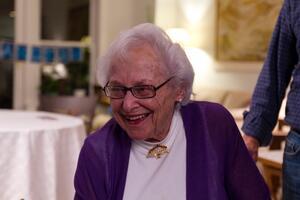Bernice Kazis
Bernice Kazis has lived in the Boston area for most of her life. She worked as a teacher and later a social worker. She also aided her husband who served as the rabbi at Mishkan Tefilah for many years. Her involvement in the movement for Soviet Jewry began as a work assignment. She was employed by Jewish Family Services of the North Shore to resettle Soviet Jewish emigres. She organized English classes and helped the newcomers find housing and jobs. She and her husband also introduced them to Jewish customs and traditions. Now in her nineties, Kazis lives in Newton, Massachusetts, where she takes classes at Lasell College and does volunteer work.
Bernice talks about Jewish identity, the role of women in Judaism, and her role models growing up. Bernice and her family were members of Mishkan Tefila, which is also where she went to school. Later, she married the rabbi of Mishkan Tefila. She describes the holidays – religious and secular – that she celebrated growing up and throughout her life. Bernice discusses her ties to Israel. Her daughter, grandchildren, and great-grandchildren live there; she tried to move to Israel with her first husband, and she regularly visits the country. Bernice tells how her married life unfolded – starting a family, losing her first husband, and eventually marrying the rabbi of her synagogue. She reflects on the ways Jewish cultural and religious traditions impact experiences and attitudes towards marriage. Bernice then talks about her role in the Soviet Jewry Movement and her involvement in resettling Jewish immigrants from Russia through her work with the Jewish Family Service of the North Shore. She comments on the role of women and Israel in the Soviet Jewry Movement. Bernice remembers the Rally to free Soviet Jewry in Washington, DC, and how it was important to bring her children and grandchildren to experience the protest. Finally, Bernice looks back on her work with Jewish Family Service, the people from Russia she became close to, and the services she provided newly arrived immigrants in the United States.



